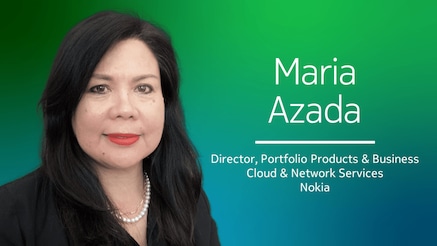Telecom SaaS for ESG
Real Conversations podcast | S5 E13 | June 29, 2023

Biography
Maria Azada leads the SaaS Portfolio Management and Strategy within Nokia Cloud and Network Services group. With more than 30 years of experience in the telecom industry, Maria seeks to drive Innovation and Transformation to ensure a sustainable telecommunication services industry.
Nokia's Maria Azada discusses how the efficiencies brought by Software as a Service (SaaS) can help deliver on environmental, social and governance (ESG) goals.
Below is a transcript of this podcast. Some parts have been edited for clarity.
Michael Hainsworth: Software as a service in the telecom industry is being used to meet ESG goals. Telecom SaaS enables providers to shrink their carbon footprint by reducing energy consumption and upgrading existing hardware without filling a landfill. Socially, Telecom SaaS makes sense, too as quick deployments can help bridge the digital divide while ensuring the entire value chain adheres to ESG goals. Nobody knows this quite like Maria Azada, the Portfolio Business and Product Strategy Director at Nokia.
MA: ESG is increasingly becoming a hot topic these days. Pressure on the planet is increasing, and there's a lot of talk about combating climate change, how to limit the use of natural resources, drive the reuse of materials. I think that as a company, as we deliver solutions, we need to focus and figure out how we can help respond to this climate change with more efficient use and reuse of the world's resources. We think that productivity is stalling, and energy costs are increasing.
And so, specifically, because I'm focusing on SaaS, how we can drive and ensure efficiency in our operations is also key and critical to the cause, to the ESG goals and strategies. I think that, as a company, Nokia will have to, well, in fact, we are including sustainability and its core to our purpose to create the technology that helps the world act together. It is a key goal. We've developed strategies on how to address this.
MH: You described what the acronym ESG means for the benefit of someone who might not know, but you have been in the ESG world for quite some time. You must have seen the interest in this evolve in recent years.
MA: Correct. It is, in fact, based on some of my early statements around pressure on the planet is increasing. And I think we have to continuously find ways to improve and drive efficiency in how we consume and reuse materials in creating our solutions and products. And I think that shifting to a SaaS business model is key and probably maybe not seen right away, but the transformation that SaaS brings, it's beyond just a transformation to a new business model. It involves a transformation on how we consume, build, use, and deploy our services. There is an operational shift involved both to our customers as well as to us as a software vendor. And we think that as we go through these shifts, move through this shift, and transform, we can benefit.
If we think about SaaS and the automation it brings, beyond it being a new business model, there's an operational shift occurring. From our customer's perspective, how the customers buy, partner, consume and operate our software will shift as they shift to SaaS. Similarly, from the perspective of the software vendor, how we build, enable, and deploy our software also is going through an operational shift. I believe that with this shift and focus on transforming both the customer journey as well as the software provider journey, we hope to remove a lot of points of friction, which could, in the end, result in helping the decarbonization of industries.
MH: Before we get into some examples of how Telecom SaaS can have a role in proper environmental, social and governance initiatives, I suppose we need to explain one more term associated with ESG, which is handprint and footprint. What's the difference?
MA: Nokia has a two-pronged approach strategy to ESG, and it's focused on maximizing our handprint. It's our positive impact on our customers, how they use and consume our products. We'd like to maximize that positive impact. From a footprint perspective, we'd like to minimize our negative impact. So how we build, deploy, to enable our solutions and services. We'd like to make a more cautious effort of minimizing the impacts. It's more internal facing. Minimizing the footprint is focused on how we as a company could help reduce the impact both environmentally as well as socially.
MH: It's just fascinating to me the idea that we can reduce our carbon impact on the planet, not just by the way we manufacture the physical hardware but use software to make that possible as well. And one of my favorite examples is the deployment of the software as a service, AVA for Energy.
MH: Tell us what that is and how that works?
MA: AVA for Energy is a new service we introduced to help companies reduce and receive energy savings consumption by deploying our AI algorithms. It detects equipment in the network that is not used, and to optimize that, we shut down unused resources so that it doesn't continue to waste energy. Now, the impact of SaaS, the impact of deploying this as SaaS, I'd like to say, is that we improve and increase the time to value. With the shift towards SaaS, we minimize the time for the customer to have access to the service instead of going through a full deployment as we currently do today with traditional deployment of software. We are able to put the ability to start the energy savings the moment they get the software. And it has been - based on our current deployments - our recent deployments, we have achieved up to a 50% speed up in less time, reduced time in enabling the service for our customers that have deployed, have chosen to deploy the service in the SaaS model.
MH: And I can imagine you're lowering the barriers of entry as well to make this kind of technology possible to reduce the impact on the environment?
MA: That is correct. And in fact, it's impressive the number of customers we're able to provide access to these solutions. From a single deployment that we've built, we're able to support many customers around the world very quickly. And that's the nature of SaaS; you build once and enable it for as many that can subscribe. And that's, in fact, a key purpose that we have established for SaaS is to lower the barriers of entry, to enable digital access to all countries, developing countries around the world, to enable them to gain easy access to the technology that we provide and the services and solutions that we are enabling.
MH: When you talk about using SaaS for ESG purposes in developing countries, it makes me think about iSIM Secure Connect; this idea that we no longer have to have a physical SIM card inside of a smartphone. The deployment, I can imagine, it gets accelerated dramatically.
MA: We've deployed the iSIM technology across up to about 12 locations in Africa from our current location in North America. They were able to establish and leverage a lot of the security practices, the certifications that we've done in our deployment, and thereby quickly enabling them access to the technology so that we were able to deploy it in many locations all around Africa. I think the other thing that we strive to do within SaaS is to shift as many manual processes as possible to digital.
So, currently today, there is a key exchange ceremony - it's a very manual process - which we've shifted to digital. There's no exchange anymore, there's no meetings taking place. And that also sped up the deployment of this service because the key exchange ceremony is now done digitally. So, as many manual processes that we have been traditionally focused on performing today, with a shift to SaaS, we'd like to shift all of these processes to digital and make it more efficient and speed up and help speed up the time to value, the time to deployment for our customers.
MH: I suppose at the end of the day, Telecom SaaS is reducing the friction in a shift to digitalization?
MA: Yes, I would totally agree with that. That is one of our key goals. Our key goal is to reduce the points of friction. I talked about the journey towards deploying, both from a customer perspective as well as from our perspective, there are many points of friction. Let me start out with the engage or discover. When a customer starts to learn about a solution or service that we have in a traditional mode, we would engage, have a lot of face-to-face meetings, travel, until it gets to the actual procurement process where there's, again, further exchange of materials.
When you shift to SaaS, we hope that within a click from the customer's desktop online, they're able to gain access quickly, like any other SaaS service. We'd like to bring this to Telco; we'd like to speed up the availability of the technology to the consumers so that network services and network capabilities are more easily consumed and accessible. Today, that's not the case, but we think that, as we shift to SaaS, we can make that happen. And as we go through that process, eliminating these points of friction, we also achieve our goals towards ESG and further helping with the decarbonization of industries and the environment.
MH: To your point, in the past a lot of what you would do is very customized for any particular Telco client, but now you're standardizing and centralizing operations and that's a critical component to successful Telecom SaaS for ESG?
MA: Yes. And I'd like to put that maybe under the governance category.
MH: For the G of ESG.
MA: One of the things that we are focusing on doing with Telco SaaS is, in fact, blueprinting and standardizing so that we can achieve the scale. We talked early on about how we were able to deploy the iSIM security services to over 12 countries just like that with a click of a button. We were impressed with ourselves with that, and there's a lot of work upfront to standardize the deployment, but the achievement and the resulting accomplishment of being able to achieve the scale that we like to do and reduce the time to value help us further our cause. And again, as well, it's in line with our ESG goals and aspirations to continue to help improve and reduce our impact on the environment.
MH: So that's the G side of the equation. But I can imagine we've essentially already talked about the S of ESG as well, that social component, because a responsible business can leverage SaaS for Telecom by promoting the speed of accessibility and, ultimately, the lowering of the barriers of entry into the digital age helps close that digital divide.
MA: Yes, and I think that's one of the key attributes of the shift to SaaS is lowering the barriers to entry, making our software more consumable and easier to access, enabling digital technology and access to anybody anywhere in the world, assuming they don't have restrictions. Some countries have restrictions as to where the software may operate, but in the case with iSIM, we were able to easily enable access. The difference between SaaS and traditional access is we don't have to go on-site on-prem to deploy and bring tons of resources, people to help with the deployment process to enable the software to be consumed. With the transition to SaaS, we are only providing access to the software. So, we build and solidify the solution once, and we're able to enable that solution to a wide customer base.
MH: What role does Telecom SaaS play in not just reducing barriers to entry, ensuring we see a streamlined process on energy consumption, but physically reducing the waste to landfill?
MA: As you know, when you shift to SaaS, when customers purchase our software, they're not buying boxes. We're not shipping hardware to customer locations, we're simply providing them with access to our software digitally and with that we're reducing the logistics concerns, logistics that come with hardware deployment. Software as a Service, thereby, reduces waste to landfill. Everything that's associated with transport and hardware deployment is totally eliminated. With the shift to SaaS, we just provide customers with access to the software. There is no hardware or on-prem deployment or any type of logistics involved in the enabling of the software.
MH: If there was one key takeaway for the listener about the value of Telecom SaaS for ESG, what would it be?
MA: I'd like to start with the shift; the transformational shift that comes with the shift to the new business model results in the reduction in the many points of friction, both from the customer journey perspective as well as from the software vendor provider perspective. And with that shift, we introduce efficiencies and extreme automation, helping to further the cause and reduce decarbonization of the industries. The other thing that results from that efficiency is the ability to make our software more consumable, and access to our software becomes readily available. We have speed to innovation, we have improved accessibility, thereby lowering the barriers to entry, and ensuring digital inclusivity.


